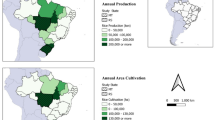Abstract
The objectives of this study were to investigate the energy input and output per hectare for sugar beet production in the northern Xinjiang Province, China, and to perform an economic analysis for farmers using drip-irrigation systems. Data were collected from 156 randomly selected sugar beet farms. The total energy input was 98,778.3 MJ ha−1. Drip-irrigation systems accounted for 50.1 % of the total energy input, and chemical fertilizers accounted for 19.9 %. The total energy input for drip-irrigated sugar beet production could be classified as direct or indirect (27 and 73 %, respectively) and renewable or non-renewable (8 and 92 %, respectively). An econometric assessment revealed that human labor (−1.59) and drip-irrigation system energy (−1.57) had the greatest effects on sugar beet production. Direct, indirect, renewable, and non-renewable energy input had positive effects on output. The energy-use efficiency was 14.5, and the benefit-to-cost ratio was 2.1. Overall, drip-irrigated sugar beet production is energy efficient and economically profitable. However, the system could still be improved by reducing energy inputs related to fertilizer (especially nitrogen), pesticides, and diesel fuel.
Similar content being viewed by others
References
Alam, M.S., M.R. Alam, and K.K. Islam. 2005. Energy flow in agriculture: Bangladesh. American Journal of Environmental Science 1: 213–220.
Ali, M., T. Ahmad, and S. Shahan. 2008. Energy use and economical analysis of potato production in Iran a case study: Ardabil province. Energy Conversion and Management 49: 3566–3570.
Ali, M., and O. Mahmoud. 2010. Economical analysis and relation between energy inputs and yield of greenhouse cucumber production in Iran. Apply Energy 87: 191–196.
Asgharipour, M.R., F. Mondani, and S. Riahinia. 2012. Energy use efficiency and economic analysis of sugar beet production system in Iran: A case study in Khorasan Razavi province. Energy 44: 1078–1084.
Erdal, G., K. Esengün, H. Erdal, and O. Gündüz. 2007. Energy use and economical analysis of sugar beet production in Tokat province of Turkey. Energy 32: 35–41.
Esengum, K., G. Erdal, O. Gündüz, and H. Erdal. 2007. An economic analysis and energy use in stake-tomato production in Tokat province of Turkey. Renewable Energy 32: 1873–1881.
Guzman, G.I., and A.M. Alonso. 2008. A comparison of energy use in conventional and organic olive oil production in Spain. Agricultural Systems 98: 167–176.
Hatirli, S.A., B. Ozkan, and C. Fert. 2005. An econometric analysis of energy input–output in Turkish agriculture. Renewable and Sustainable Energy Reviews 9: 608–623.
Hatirli, S.A., B. Ozkan, and C. Fert. 2006. Energy inputs and crop yield relationship in greenhouse tomato production. Renewable Energy 31: 427–438.
Kizilaslan, H. 2009. Input–output energy analysis of cherries production in Tokat Province of Turkey. Apply Energy 86: 1354–1358.
Malnou, C.S., K.W. Jaggard, and D.L. Sparkes. 2006. A canopy approach to nitrogen fertilizer recommendation for the sugar beet crop. European Journal of Agronomy 25: 254–263.
Mantineo, M., G.M. D’agosta, V. Copani, C. Patane, and S.L. Cosentino. 2009. Biomass yield and energy balance of three perennial crops for energy use in the semi-arid Mediterranean environment. Field Crop Research 114: 204–213.
Morteza, Z., O. Mahmoud, and A. Asadollah. 2010. A comparative study on energy use and cost analysis of potato production under different farming technologies in Hamadan province of Iran. Energy 35: 2927–2933.
Naeimeh, S., R. Shahin, M. Hossein, and M. Ali. 2011. An analysis of energy use and relation between energy inputs and yield, costs and income of garlic production in Iran. Renewable Energy 36: 1808–1813.
Narges, B., O. Mahmoud, and A. Hojat. 2011. Energy and economic analysis of greenhouse strawberry production in Tehran province of Iran. Energy Conversion and Management 52: 1020–1025.
Rajabi, H.S., K. Alireza, and A. Raze. 2011. Energy use patterns and econometric models of grape production in Hamadan province of Iran. Energy 36: 6345–6351.
Ramazan, T., S. Sinan, and A. Bilal. 2010. Comparison of energy of irrigation regimes in sugar beet production in a semi-arid region. Energy 35: 5464–5471.
Reza, G., M. Farzad, A. Shahram, F. Hassan, K. Surror, T. Mozhgan, S. Sara, A. Sepideh, and A. Hassan. 2011. A case study of energy use and economical analysis of irrigated and dryland wheat production systems. Apply Energy 88: 283–288.
Shahin, R., S.H. Mousavi, and M. Ali. 2010. Modeling and sensitivity analysis of energy inputs for apple production in Iran. Energy 35: 3301–3306.
Singh, H., D. Mishra, and N.M. Nahar. 2002. Energy use pattern in production agriculture of a typical village in Arid Zone India—Part I. Energy Conversion and Management 43: 2275–2286.
Taylor, A.E.B., P.W. O’Callaghan, and S.D. Probert. 1993. Energy audit of an English farm. Apply Energy 44: 315–335.
Tognetti, R., M. Palladino, A. Minnocci, S. Defline, and A. Alvino. 2003. The response of sugar beet to drip and low-pressure sprinkler irrigation in southern Italy. Agricultural Water Management 60: 135–155.
Unakitan, G., H. Hurma, and F. Yilmaz. 2010. An analysis of energy use efficiency of canola production in Turkey. Energy 35: 3623–3627.
Zhang, J.W. 2011. Plantation and cultivation of drip irrigated sugar beet in arid area. Xinjiang Agricultural Science & Technology 1: 14–16 (in Chinese).
Funding
This study was funded by the Chinese Ministry of Science and Technology (Grant Numbers 31260299, 31560169, 212201, 2015DFA11660, and RCZX201314).
Author information
Authors and Affiliations
Corresponding author
Ethics declarations
Conflict of interest
The authors declare that they have no conflict of interest.
Rights and permissions
About this article
Cite this article
Hua, F., Yangyang, L., Cong, F. et al. Energy-Use Efficiency and Economic Analysis of Sugar Beet Production in China: A Case Study in Xinjiang Province. Sugar Tech 18, 309–316 (2016). https://doi.org/10.1007/s12355-015-0405-y
Received:
Accepted:
Published:
Issue Date:
DOI: https://doi.org/10.1007/s12355-015-0405-y




